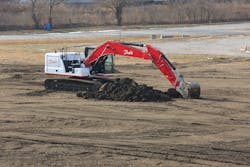Creation of more efficient hydraulic systems can reduce the energy consumption of the machines into which they are integrated, leading to fewer emissions produced. This is a concept Danfoss Power Solutions is looking to prove with its Dextreme Max system for excavators.
The company has received a grant from the U.K. Government’s Department for Energy Security & Net Zero through the Red Diesel Replacement Phase 2 (RDR2) Competition. With this grant, Danfoss will convert a 30-ton electric excavator to utilize its Dexteme Max system featuring the company's Digital Displacement hydraulic pump, the DDP1X0D.
Hydraulic system efficiency gains will be achieved with the Dextreme Max system due in part to the energy recovery capabilities possible with the DDP1X0D pump. Danfoss expects the system will help to reduce an excavator's energy consumption by as much as 50% due to the improved efficiency of the hydraulics — which can lead to efficiency improvements in other parts of the machine such as reducing the amount of battery power required.
READ MORE about the grant and the importance of reducing emissions from excavators.
Power & Motion spoke with Leif Bruhn, head of Digital Displacement at Danfoss Power Solutions, about the project and how the technologies involved can help to improve hydraulic system efficiency and how that benefits efforts to decarbonize construction equipment.
*Editor's Note: Questions and responses have been edited for clarity.
Power & Motion (P&M): Why is the company choosing to prove the Dextreme Max system with the grant from the U.K. Government’s Department for Energy Security & Net Zero program as opposed to one of the other versions of the Dextreme system?
Leif Bruhn (LB): Our other Dextreme systems (Swap and Flex) are past the research stage and are being commercialized to reduce diesel machines' fuel consumption. Now that the industry sees what’s possible, we want to demonstrate what is possible when applying a fundamental change to system architectures to meet our customers’ challenging carbon dioxide (CO2) targets.
The support of the U.K.’s RDR2 grant program gave us the confidence to invest in developing the additional features required for Dextreme Max in the pump, controller, and system. Dextreme Max matches the ambition of the RDR2 grant program for a first-of-a-kind demonstration, acting as a "beacon" to lead the industry toward complete decarbonization.
P&M: What enables the Digital Displacement pump to do energy recovery in the Dextreme Max system?
LB: Our DDP1X0D pump has a digital valve for each pumping cylinder. In Phase 1 of the Red Diesel Replacement program, we upgraded that valve to a new design that allows hydraulic energy recovery and transformation, and we demonstrated very high efficiencies, which will shortly be published at the 2023 International Symposium on Fluid Power and Motion Control (FPMC).
We’ve adopted this new design as the core of the DDP1X0D range. This means that every DDP1X0D pump will share the same design, whether fulfilling the role of a pump (in a traditional system) or the role of a pump/motor/transformer (as in our Dextreme Max system).
Just upgrading the pump is not enough to realize all the benefits; we also need to change the actuator control valves to remove throttling and route fluid back to the pump for energy recovery. So, it’s a combination of a new component and a new system architecture that unlocks the full potential.
P&M: Why has the company chosen to convert an electric excavator as opposed to testing the system on a diesel-powered machine?
LB: One of the strengths of the Dextreme systems is that they can be applied regardless of the energy source: diesel, synthetic fuel, battery, or hydrogen. So, OEMs can follow a single technology roadmap to improve efficiency across their entire range. Our Dextreme Max system shows incredible economic and environmental value in large battery-electric excavators. Dramatically increasing energy efficiency in the hydraulic circuit enables OEMs to reduce their battery size/costs, and operators to reduce their charging costs and charge more machines with the same electrical capacity.
The reduction in the total cost of ownership of a large electric excavator is enough to show a positive business case for electrification. We believe this is essential for the electrification of larger machines to be adopted at a larger scale.
P&M: What design aspects of this system enable it to achieve such high efficiency gains?
LB: The pump has a radial piston mechanism with a digitally controlled valve to adjust displacement; this gives about half the energy losses compared to the conventional swashplate pump. But to reduce energy losses at the system level, we also take advantage of the pump’s multiple independent fluid outlets; these are dynamically allocated to each actuator so that fluid is supplied at the pressure needed by each actuator without throttling.
P&M: Are there other changes which will be made to the machine to reduce its energy consumption and emissions? If so, what are those and how will they help to do so?
LB: The base machine is a 30T battery-electric excavator with a state-of-the-art Editron electric drive system by Danfoss and field-swappable battery packs. Our focus for the project will be to upgrade the hydraulic system with Dextreme Max; we’ll keep other aspects of the system design of the machine the same to allow for a before-and-after comparison.
We expect that the improved operating efficiency of our Dextreme system will allow us to completely remove one of the three battery packs and maintain the same runtime performance and endurance of the baseline machine.



